Rooftop Statues
“I try to avoid looking forward or backward, and try to keep looking upward.”
Charlotte Bronte
Sometimes hidden away above London's skyline, raise your head to view the Rooftop Statues, which includes some of the many overlooked sculptures in London.
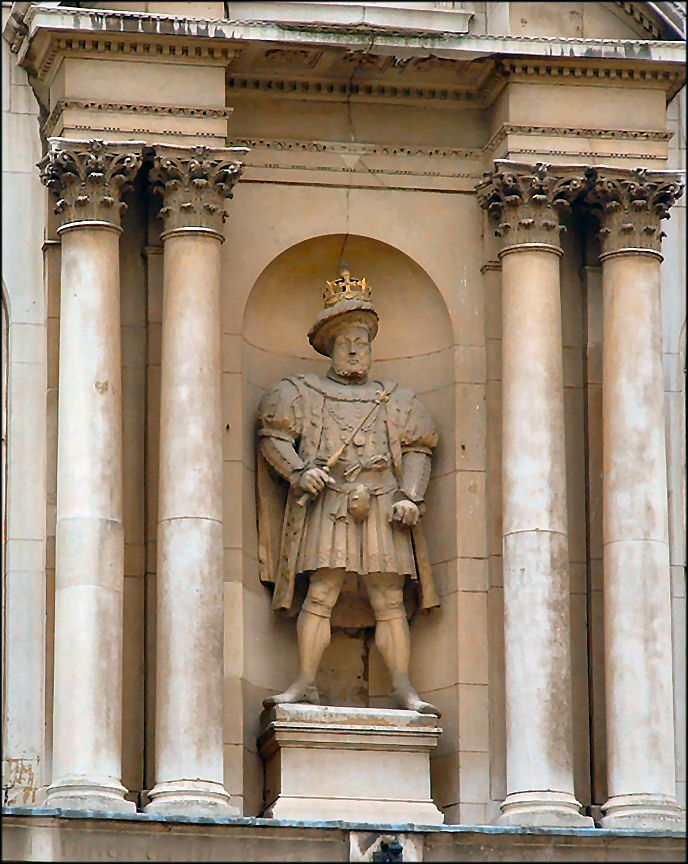
This is the only outside statue of King Henry the VIII in London. It can be viewed, sited on top of the main gateway of London's oldest hospital Saint Bartholomew's Hospital (St Bart's). In 1546, King Henry VIII granted St Bartholomew's Hospital to the City of London. At the same time, his statue was installed above the gates where it still stands today.
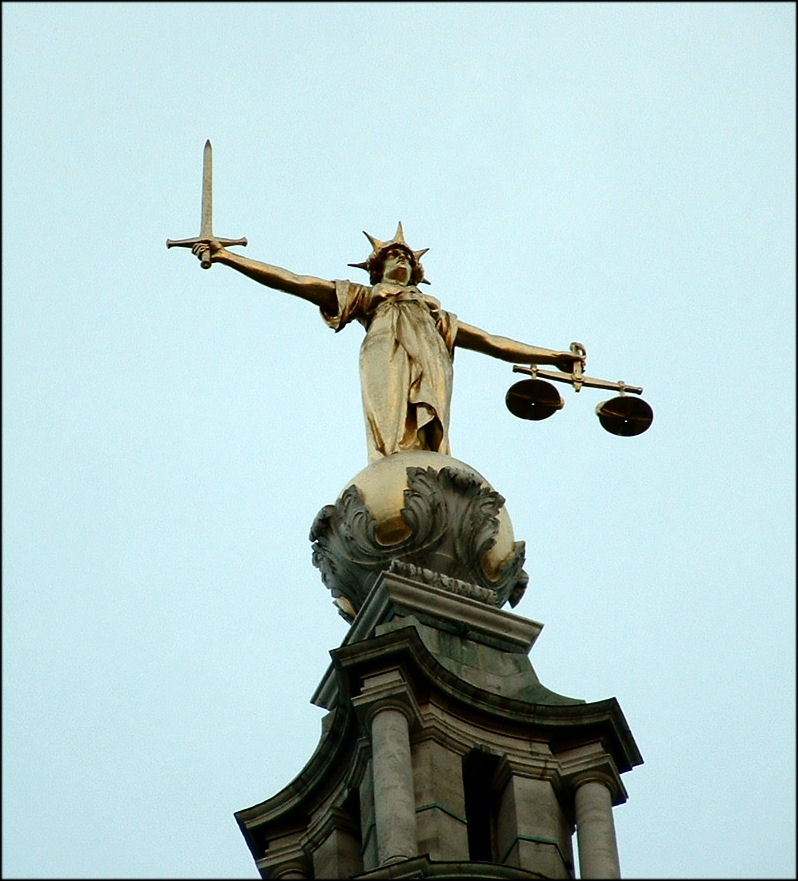
The Scales of Justice stands on top of England's largest Court House, the 'Old Bailey.' Built in 1907, on the site of Newgate Prison, with some of the old bricks being recycled. The Old Bailey was designed by E.W. Mountford. The name 'Old Bailey' is taken from the street name where the court is situated, which was named after the 'old bailey' being the outer Roman wall which once stood here.

"Justice" by Hibbert Binney, is yet another scale and sword rooftop statue. Easily missed looking out over Piccadilly from the corner of St James Street.
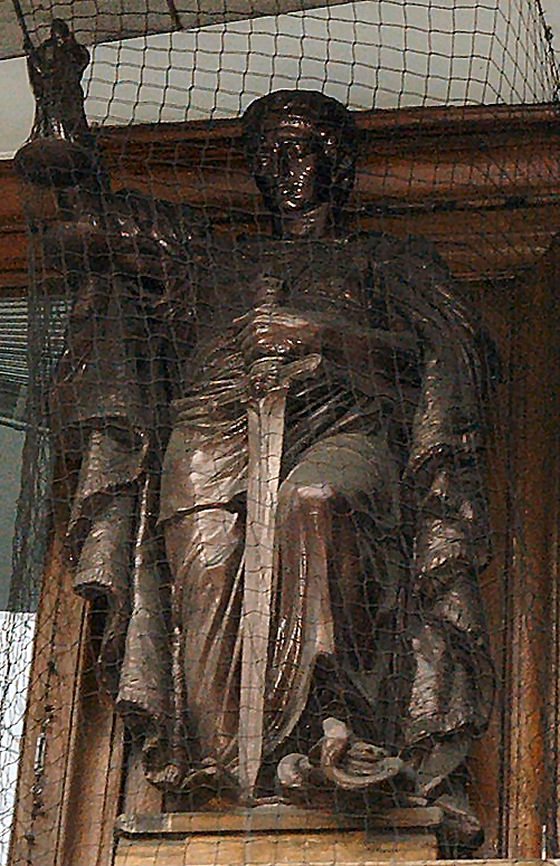
The third of our scales of justice statue can be discovered near the Law Courts in the Strand. Hidden in an alcove which allows it to go unnoticed, partly hidden behind netting to keep the pigeons away.

If you've ever felt guilty of stuffing away too many cakes, then this statue is for you. Located on the corner of Cock Lane and Guiltspur Street in the city of London. This marks the spot where the Great Fire of London of 1666 finally stopped. The guilt boy was erected to remind people of the fire, which they claimed was caused by gluttony. The original building on this spot was The Fortune of War tavern, where the sign of the magpie once stood. It was from this bird the corner became known as "Pie Corner."
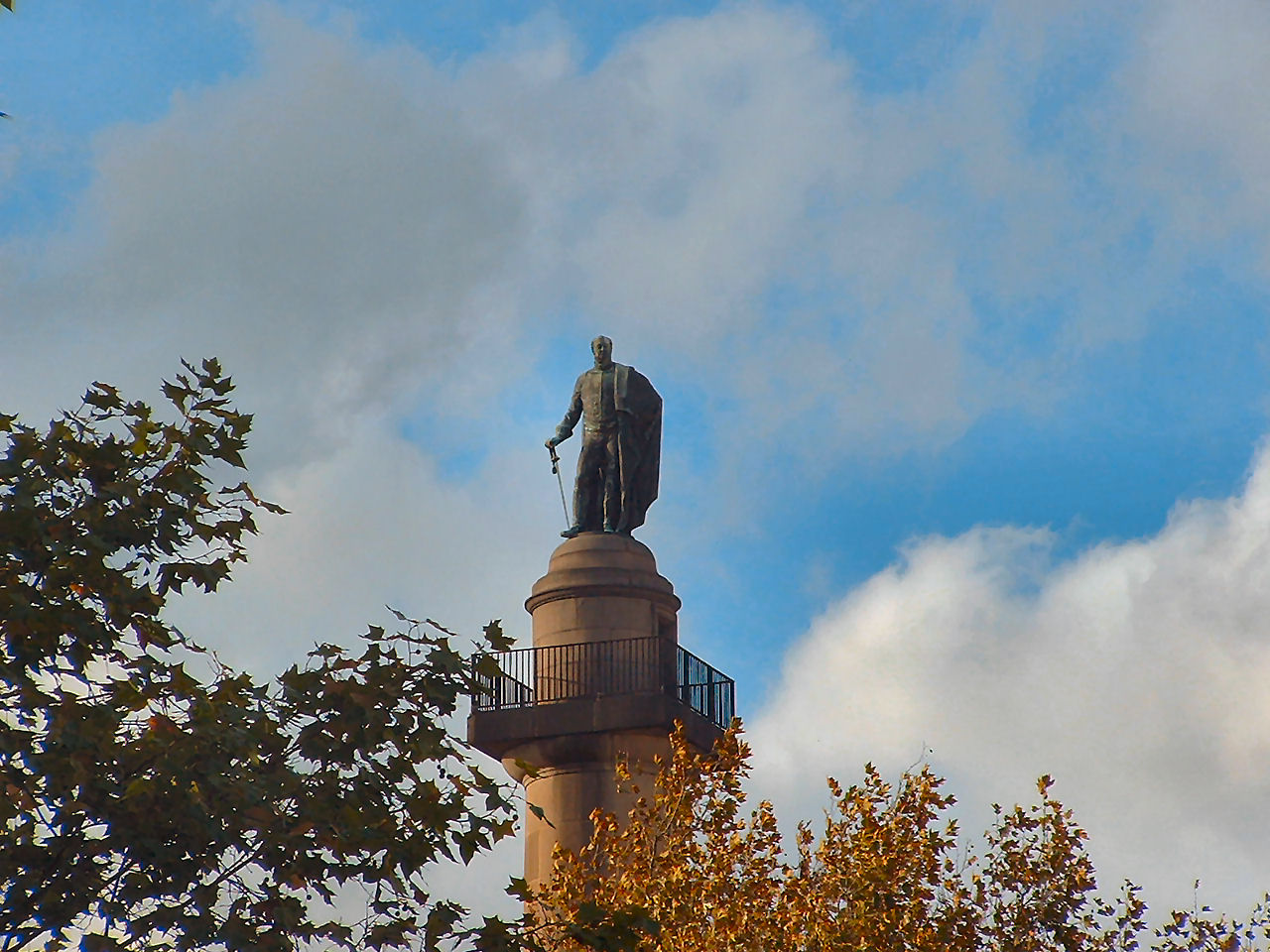
Frederick, (1763 - 1827) The Grand old Duke of York, (who had ten thousand men, he marched them up to the top of the hill and he marched them down again)
Stands on top of the Duke of York Column at a height of 124 feet. Frederick the son of George III and the brother of George IV, had a disastrous military career, it was said he was placed so high to keep him away from his creditors. Most of the cost of this memorial was met by stopping one day’s pay from every soldier in the British army, which made him even more unpopular. The column was designed by Benjamin Wyatt, with the bronze statue cast by Westmacott. Standing on part of the site of Carlton House, which was the royal residence of George IV and remembered by the street names, Carlton House Terrace and Carlton House Gardens.
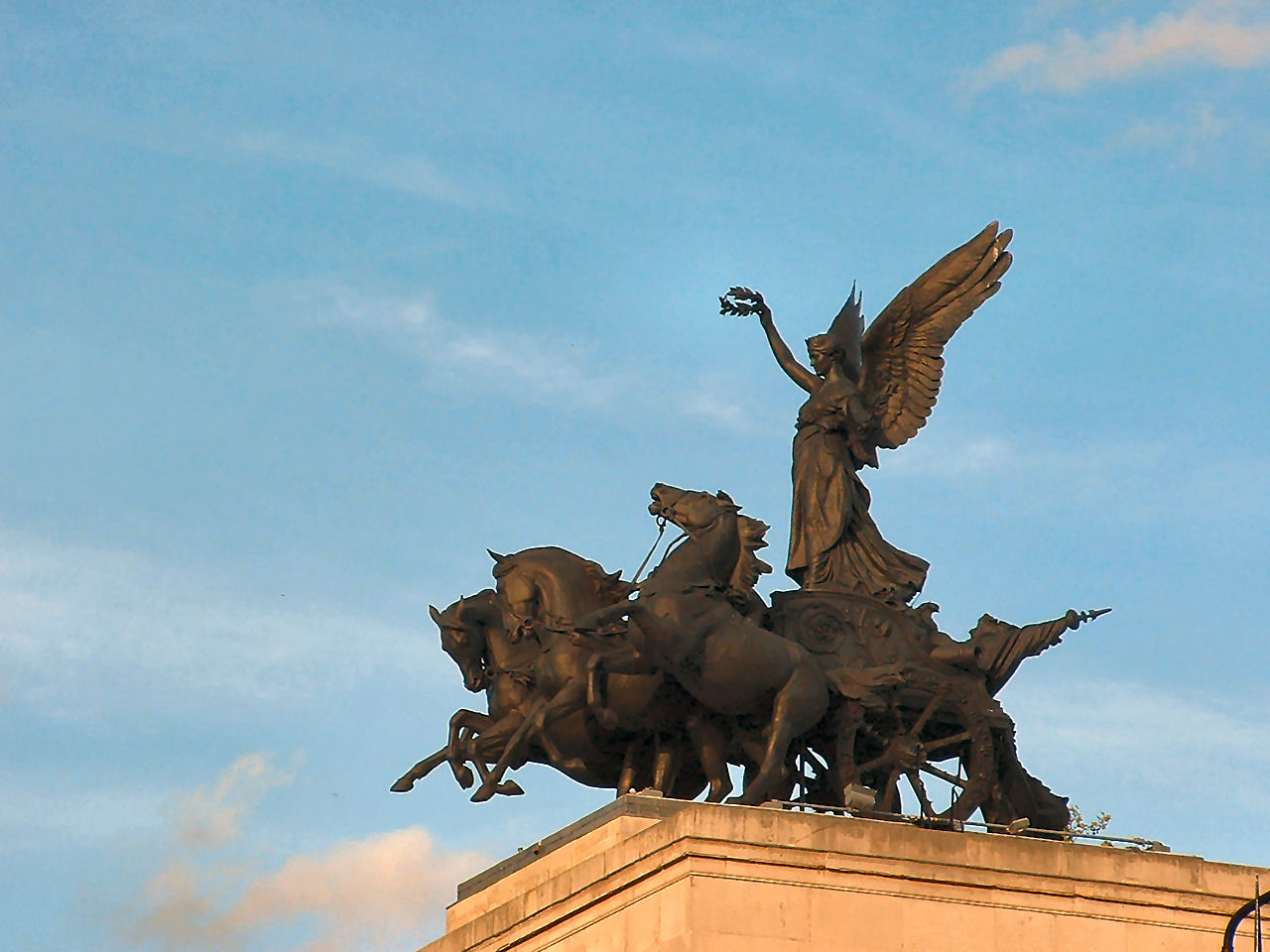
This masterpiece "Quadriga" by Adrian Jones (born 1848 - died 1935) was commissioned by King Edward VII, standing as it does on the top of the Wellington Arch, Hyde Park Corner. Quadriga (taken from the Latin Quadri-, four, and jungere, to yoke) is a four-horse chariot, raced in the original Olympic Games and other sacred sports. The Statue was cast in a garden in Old Church Street Chelsea, by Adrian Jones. This ironwork weighs 40 tons and dates from 1912.
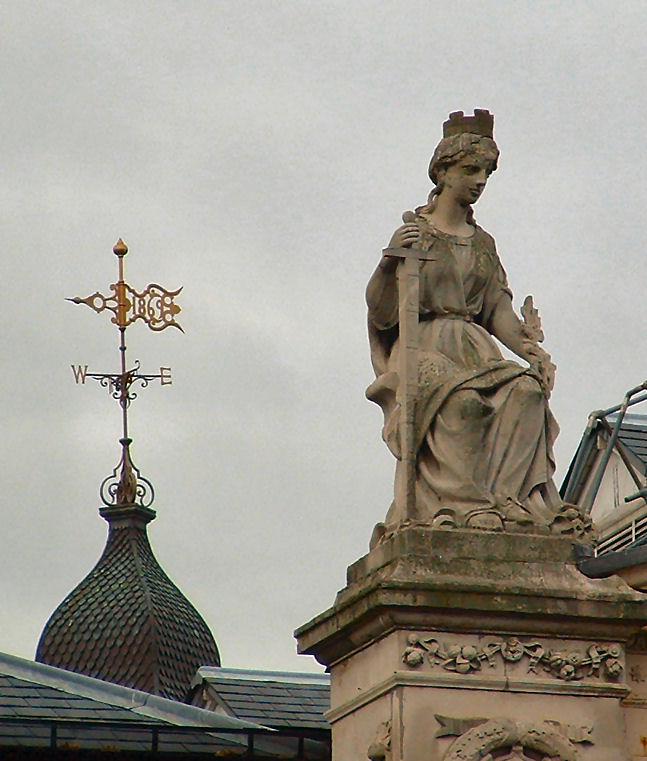
This lady looking every bit a queen is perched above the rooftops of Smithfield meat market, with her sword at her side. The beautiful ornamental weather vane is from 1869, with the wind blowing in a southwesterly direction.How many market porters have lifted their heads up at this statue is as unknown as the forgotten lady herself.

Peering out from the Ledge of a top floor window of Saint Andrews Courthouse is Roof Man, he is looking over St Andrew Hill towards the new Sainsbury's head office, his left hand contorted while his right-hand hides beneath a garment. Like a true rooftop statue, he remains unnoticed by the passers-by.
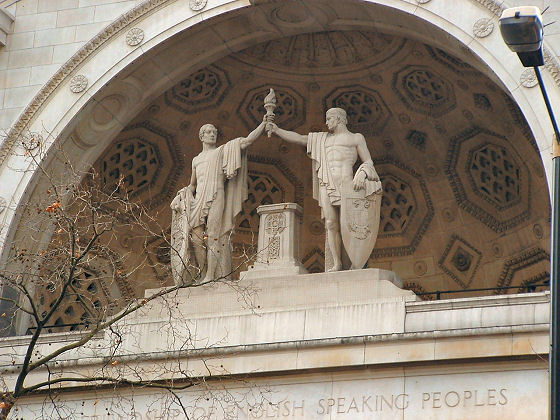
Peering out of the B.B.C World Service Bush House building in the Aldwych, is the two Grecian men, holding the Olympic flame. The figure on the right represents America and its arm was blown off by a bomb in 1944. It came to symbolise America's sacrifice in the war - until 1977 when an American company subscribed to have the arm replaced.
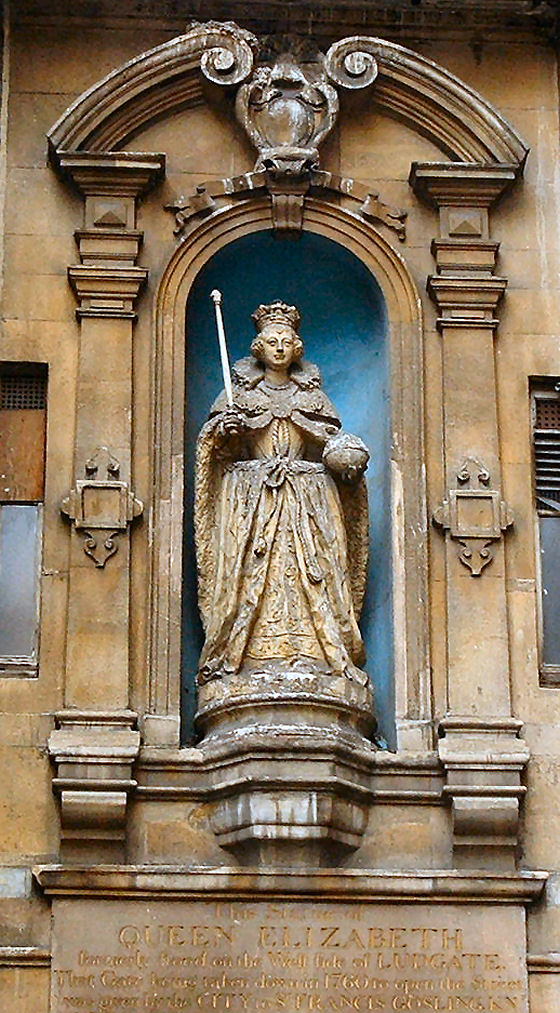
Tucked away inside the gates of St Dunstan's-in-the-West, Fleet Street, it is the only statue of Elizabeth I of England, carved in her own lifetime, dating from 1586. This statue was once more prominent on Ludgate Hill at the old "Lud" gate, a gateway near the bottom of the hill. When the ancient gateway was demolished, the statue was removed and placed in the basement of a nearby pub for storage. Forgotten over the centuries it was rediscovered as late as 1839, by workmen demolishing the old public house. Later it was found a new home, with its final resting place in the alcove of obscurity.
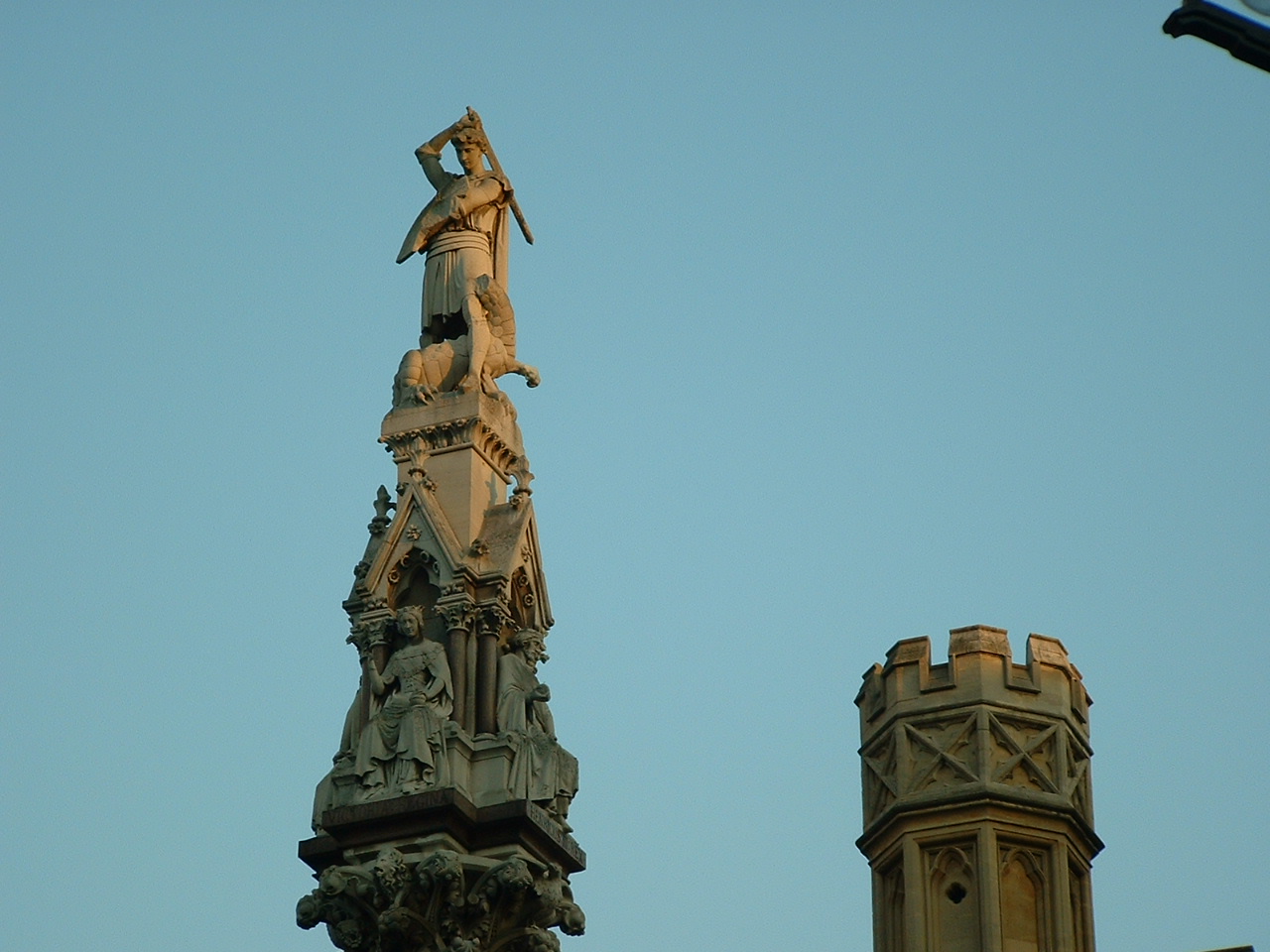
This slayer of creatures stands on a high column in the courtyard above the rooftop of Westminster Abbey. He is about to give what appears to be a headless dragon a nasty blow with his upheld sword. It commemorates scholars of nearby Westminster School who died in the Crimean War.
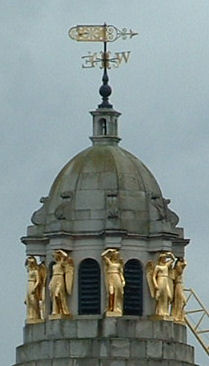
These golden Angels appear above the rooftops overlooking Regents Park. Although they are under the weather vain and they seem to be caught with the sun as their hands shield their eyes. They go completely unnoticed by most people enjoying the park and they are most certainly Angels on high.
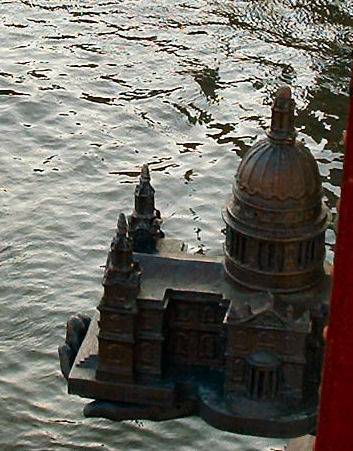 Giving St Paul's a helping hand.
Giving St Paul's a helping hand.
This bronze figure, holding the rather detailed model of St Paul's Cathedral in her hand, was sculpted by London Born Alfred Drury 1856-1944. Hiding in an alcove on Vauxhall Bridge is one of eight female figures on the bridge representing the Arts and Sciences, dating from 1909, with others also Sculpted by Frederick Pomeroy.

The sad thing with these sculptured gems are only noticeable to riverboat traffic, passing beneath Vauxhall Bridge, or by craning your head over the side of the bridge! Notice on the left side of the Bridge, you can see trickles from the River Tyburn outflow, the Tyburn being one of London's lost underground rivers.
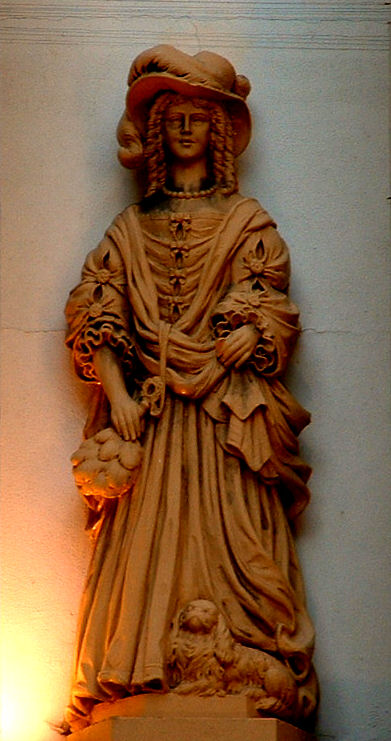
This rooftop statue is hard to spot, hidden as it is in the alcove above the main entrance to Nell Gwyn House. It goes unnoticed by the fast moving traffic along Sloane Avenue. This is the only statue of a courtesan and the most famous one at that, the mistress of King Charles II.
Notice the King Charles Cavalier at her ankles. I wonder if this dog named before or after her royal affair?
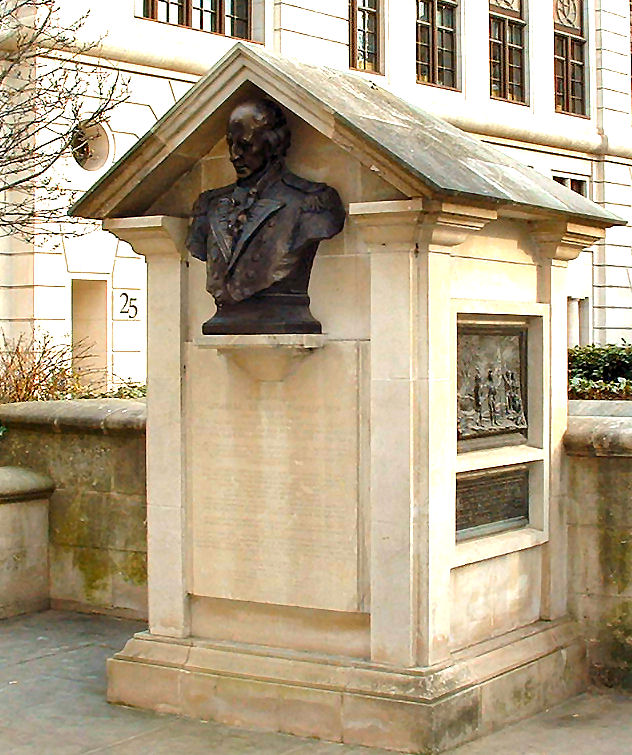
First unveiled in 1932, is the bust and two brass plates of Arthur Phillip, in St Mildred's Church Bread Street, before the world war, two bombs destroyed the church. Now standing in Watling Street, one of the most unseen heroes of English history. It was Arthur Phillips who sailed from Portsmouth with the first thousand settlers to colonise Australia, first landing at Botany Bay, before moving a little north into what he described as "the finest harbour in the world," or what we now know as Sydney.
One of the brass plates shows five men raising the flag at Sydney, on Wednesday 23 January 1788, the other shows the official occasion three days later when New South Wales was founded.
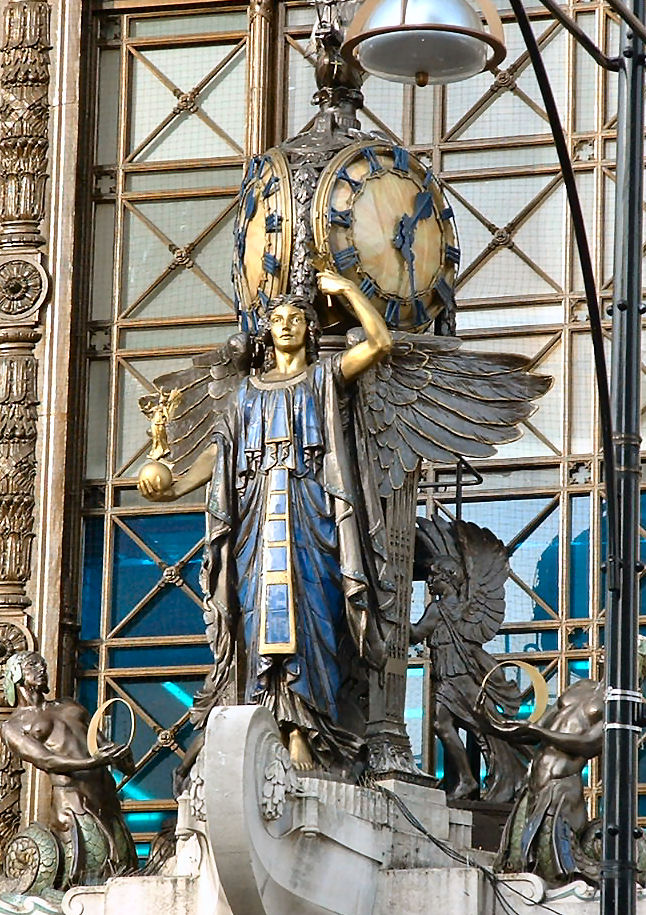
The largest department store on Oxford Street is Selfridge's, where high above the Art-Deco main entrance, there is a statue of the Queen of Time, riding in her Ship of Commerce. With the mad rush of shoppers how many have the time even to look up at this Queen?
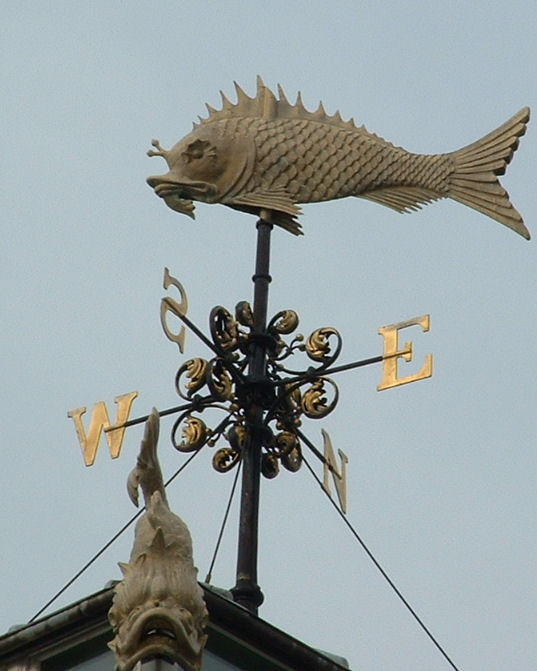
High above the Old Billingsgate market building is London's Flying' Fish. The two have a bird's eye view of the River Thames and have seen many changes to the place over the last century, with the changes going on below. Gone are the Fish Market porters, with iron wheeled carts rattling along the cobbled stone road. Gone are the Docks and the River traffic down below, now they see the old fish market used as a corporate venue, with largely stretched limos coming and going. Perched above the skyline they keep their eyes on the weather.
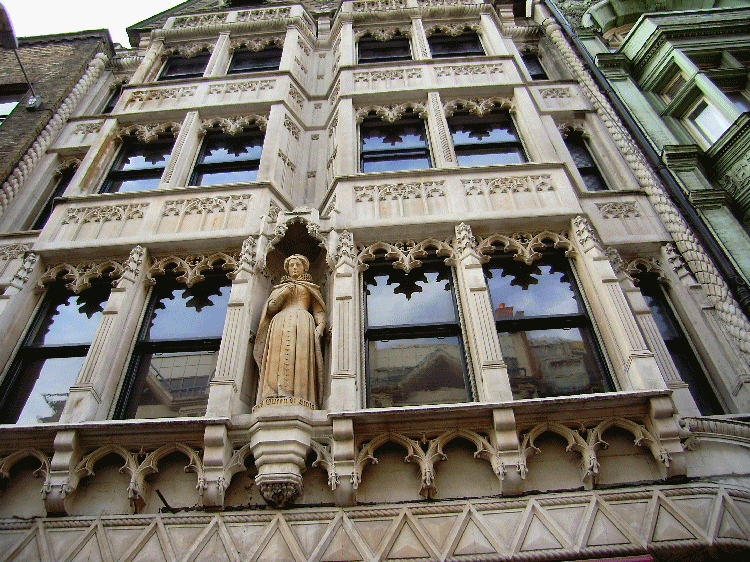
Through the ages, footsteps have trod along Fleet Street, too busy to look up at the Queen who lost her head on the orders of her cousin, Elizabeth I in 1587. She spent her entire life as the Scottish Queen, for only six days after she was born her father James V died, and from then on she became Mary Queen of Scotland.

On the north side of Bloomsbury Way is St George's Church, erected in 1731 by Nicholas Hawksmoor, adorned by a handsome portico, with the above ledge having a sleepy upside down Lion and a Unicorn, with a curious pyramidal spire topped by a Statue of George I.
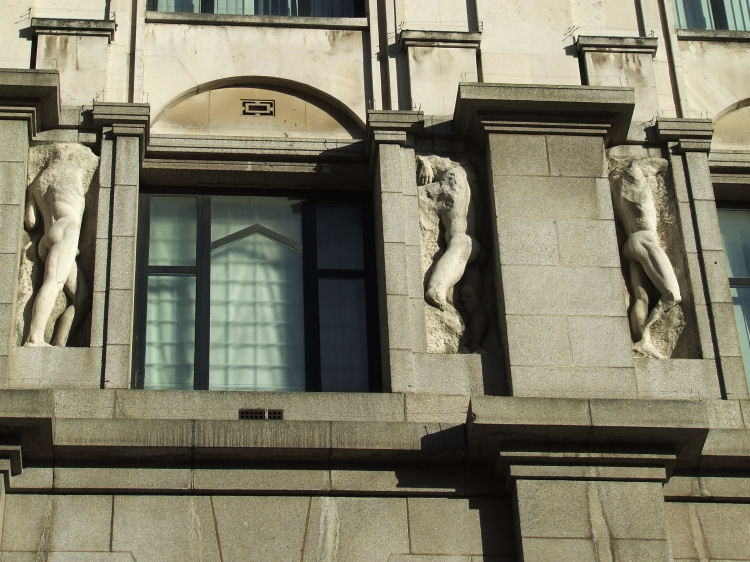
Standing high above in the alcoves of the window ledges of Zimbabwe House, are these Mutilated Rooftop
sculptures by Jacob Epstein. They date from 1908 when Charles Holden designed the building for the British Medical Association.
These statues caused quite a stir in their time, because of their naughty bits, although the British Medical Association stood by Epstein and they were allowed to flourish.
It was not until the Rhodesian High Commission bought the building some 30 years later that the castration began.
Said to have been done for health and safety reasons because the dangly bits were in danger of falling off in bad winds because they were decaying somewhat. Shrouded in mystery the statues survive in their present form.
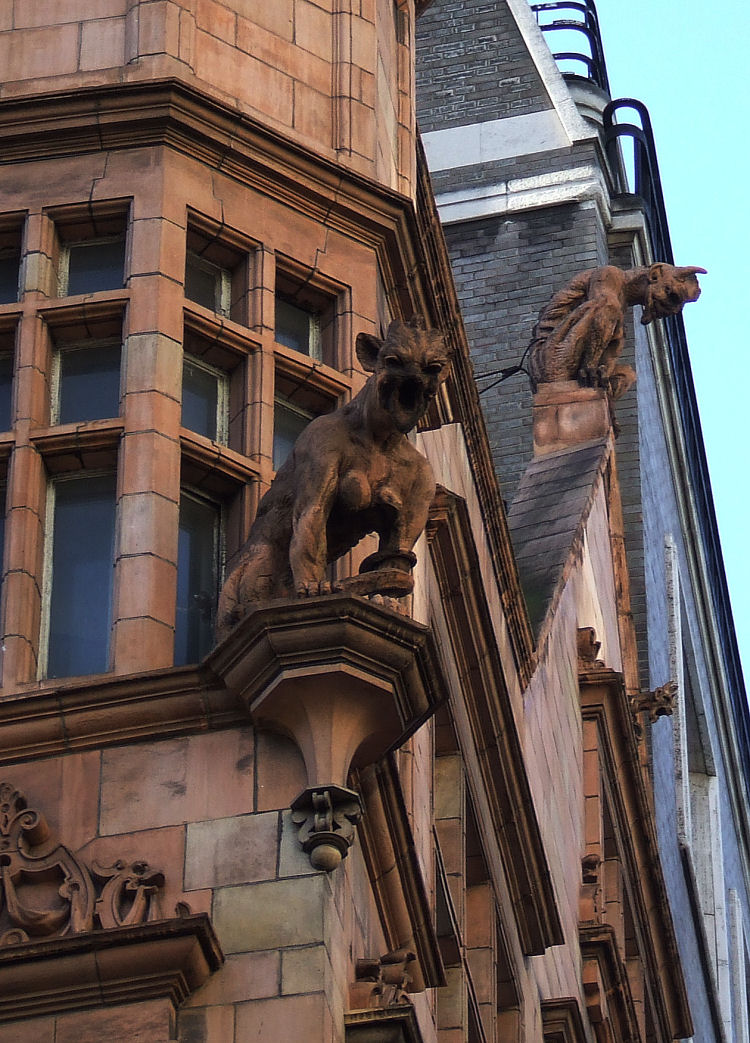
St Peter’s Church, Cornhill, has three angry devils who pour scorn on anyone entering the said church.
The story behind them is thus, during the building of the office block next door to the church, the builders nicked a foot of the church ground.
This act was noted by the rector, the building plans were put back and the architect was made to re-plan his works.
So bitter was the architect, that he engrossed the rectors face upon one of the devils, and set three devils upon the roof
to add curses to anyone that entered the church.
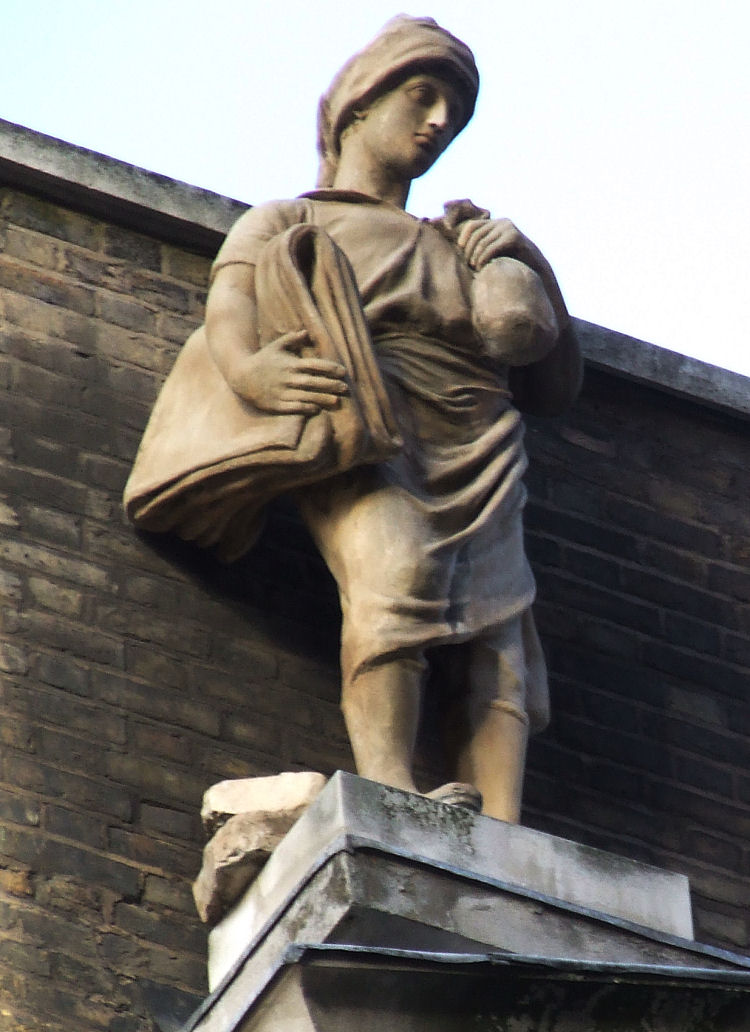
Above the Royal Society of the Arts rooftop, as you would expect, are some fine sculptures, three in all. I go for this rather dejected soul with her blanket across one arm and her little bundle of joy held tight in her other hand. Watch out for the paving stones by her right foot!
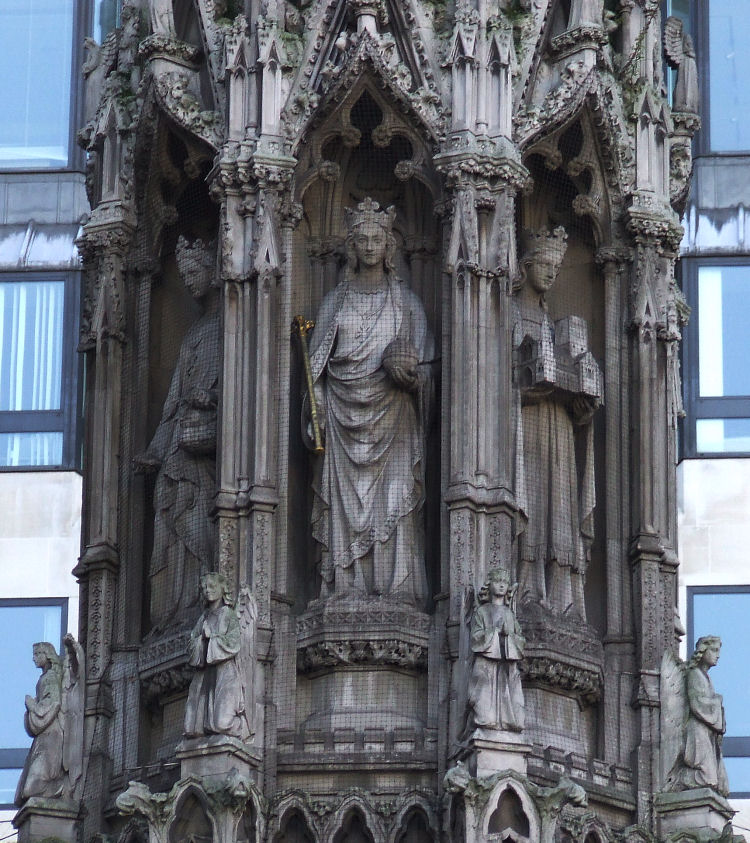
The Eleanor cross at Charing Cross Station has a lot of Rooftop appeals as it is all of 70ft high. The original cross stood a few hundred yards away from where Charles I now sits upon his horse at the top of Whitehall.
The Eleanor Crosses were 12 lavishly decorated stone monuments that King Edward I had placed wherever Queen Eleanor's funeral cortège stopped to rest,
this being the final stop before Westminster Abbey. The original cross was destroyed in 1647, with this replacement cross being erected in 1865,
in front of the Station forecourt a year after the Station was first opened.
The legend of the grasshopper
A poor little boy deserted by his parents was lying half-dead in a Norfolk meadow and would have most certainly perished had it not been for a noisy grasshopper attracting a passer-by to look in the direction of the starving lad. The kind passer-by adopted this poor wretch found in the field and gave him his Norfolk family name of Gresham. This young lad called Thomas was to one day build the greatest London exchange where merchants could transact business and high above the steeple he raised a great golden grasshopper, so all men might know and wonder at the strange fortune this creature had helped to build. The truth though is less romantic.
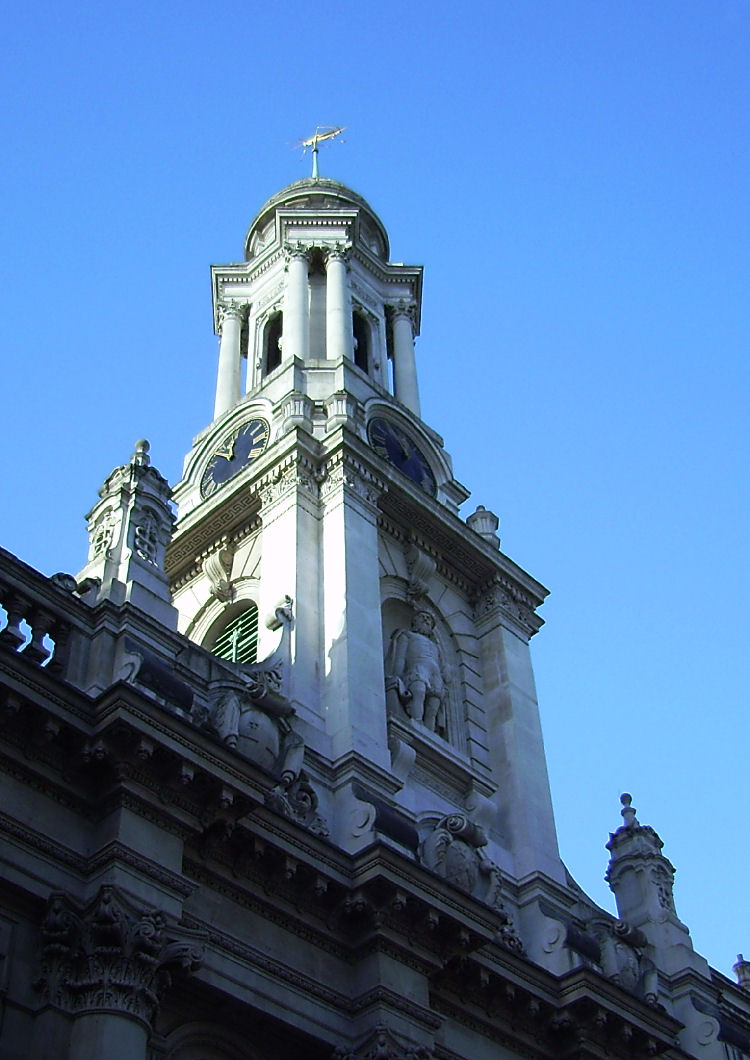 Above the steeple of the Royal Exchange is the world’s biggest grasshopper
Above the steeple of the Royal Exchange is the world’s biggest grasshopper
Born in London in 1519, Sir Thomas Gresham, descendent of a Norfolk family and the son of the knight Sir Richard Gresham, who was a leading London Merchant and one time
Lord Mayor of London. Thomas was rewarded for his loyal services to King Henry VIII in negotiations for loans with merchants from abroad and bestowed a knighthood.
Having won and lost favour with Queen Mary, Thomas became the flavour of his day with Queen Elizabeth as financial agent of the crown.
He later built at his own expense the Royal Exchange at Bank Junction, Cornhill, in exchange for the London merchants buying the land.
A rebuilt version of the Royal Exchange stands on the same spot to this day and supports the golden grasshopper emblem of the
Gresham family on top of the dome, along with his rooftop statue looking towards his Bishopsgate home. Sir Thomas Gresham died in 1597. As for the grasshopper, it was a pun on the family surname Gresham taken from their Norfolk estate of Gresham a corruption of ‘grass ham’ meaning homestead or farm of grain.
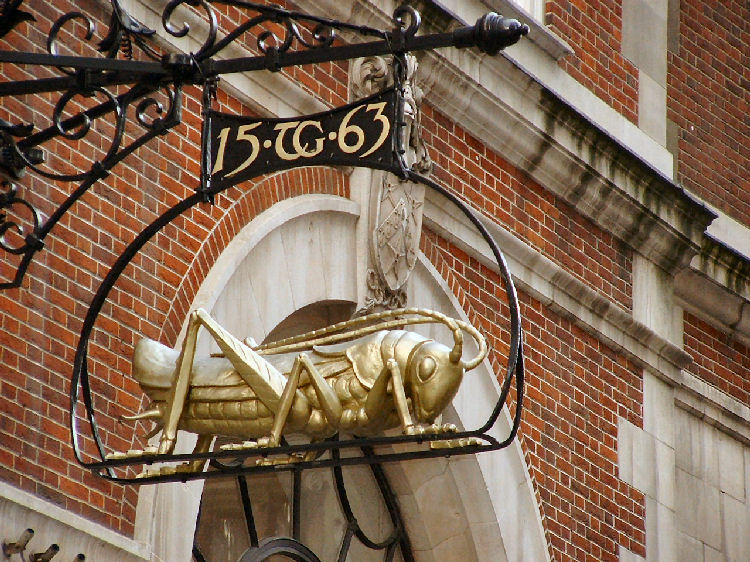
Above the grasshopper in Lombard Street is the sign, 15.TG.63 for it was in 1563 that Thomas Gresham offered to build the Royal Exchange at his own expense. The first stone was laid by Gresham on June 7, 1566, with the building completed eighteen months after.
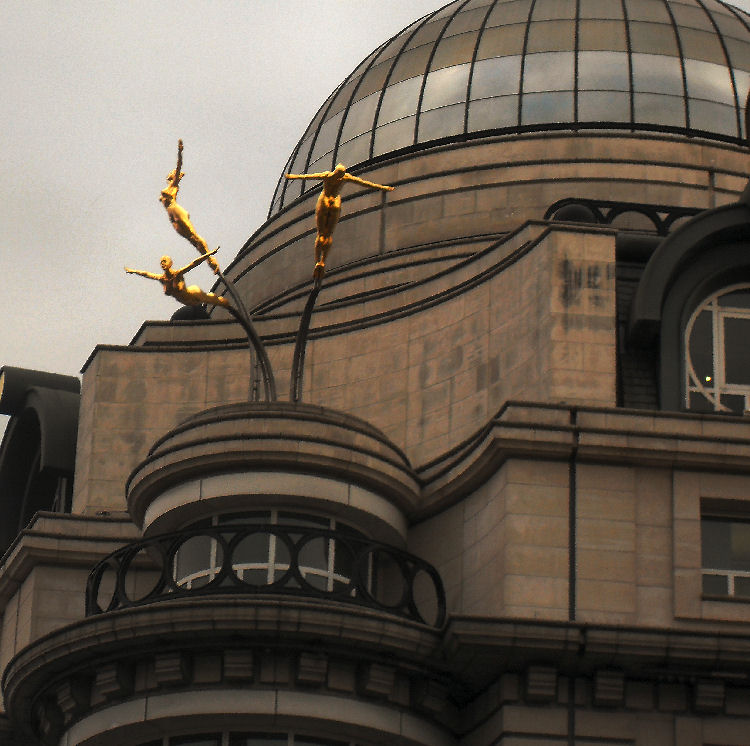 Three Gold Swimmers
Three Gold Swimmers
Competitive diving having its roots in Britain, Olympic gold with these three gold divers high above the rooftops in Coventry Street. I have tried to discover why they are here on top, even Westminster Council who’s jurisdiction the divers fall into have not answered my question. Meanwhile, they go relatively unnoticed by the thousands who trudge passed with their heads down.
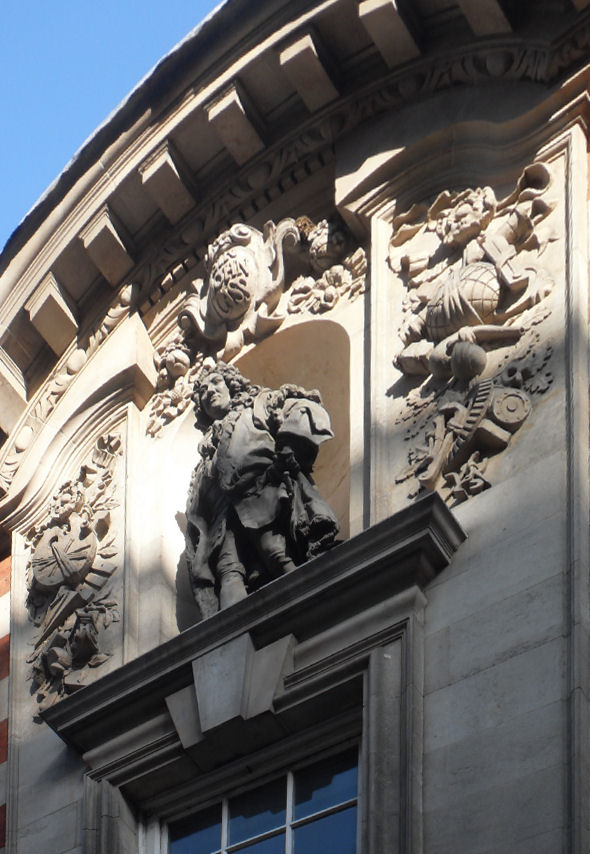
Sir John Cass peering from his secret hideaway near Aldgate, just a stone's throw away from his birthplace and the school he founded. Sir John Cass was born in the City of London in 1661 and,
served as both Alderman and Sheriff of London. Also an MP for the City and knighted in 1713. Across the road from his Rooftop
Statue he set up a school for 50 boys and 40 girls in a building in the churchyard of St Botolph-without-Aldgate.
He died in 1718 of a brain haemorrhage. Leaving only three pages of his Will, the will was contested but was finally upheld by the Court of Chancery 30 years after his death. The school, which by this time had been forced to close,
was re-opened, and the Foundation established. Today the school still survives in Dukes Place, and in Hackney, there is a housing trust bearing his name as well as Cassland Road also named after him.
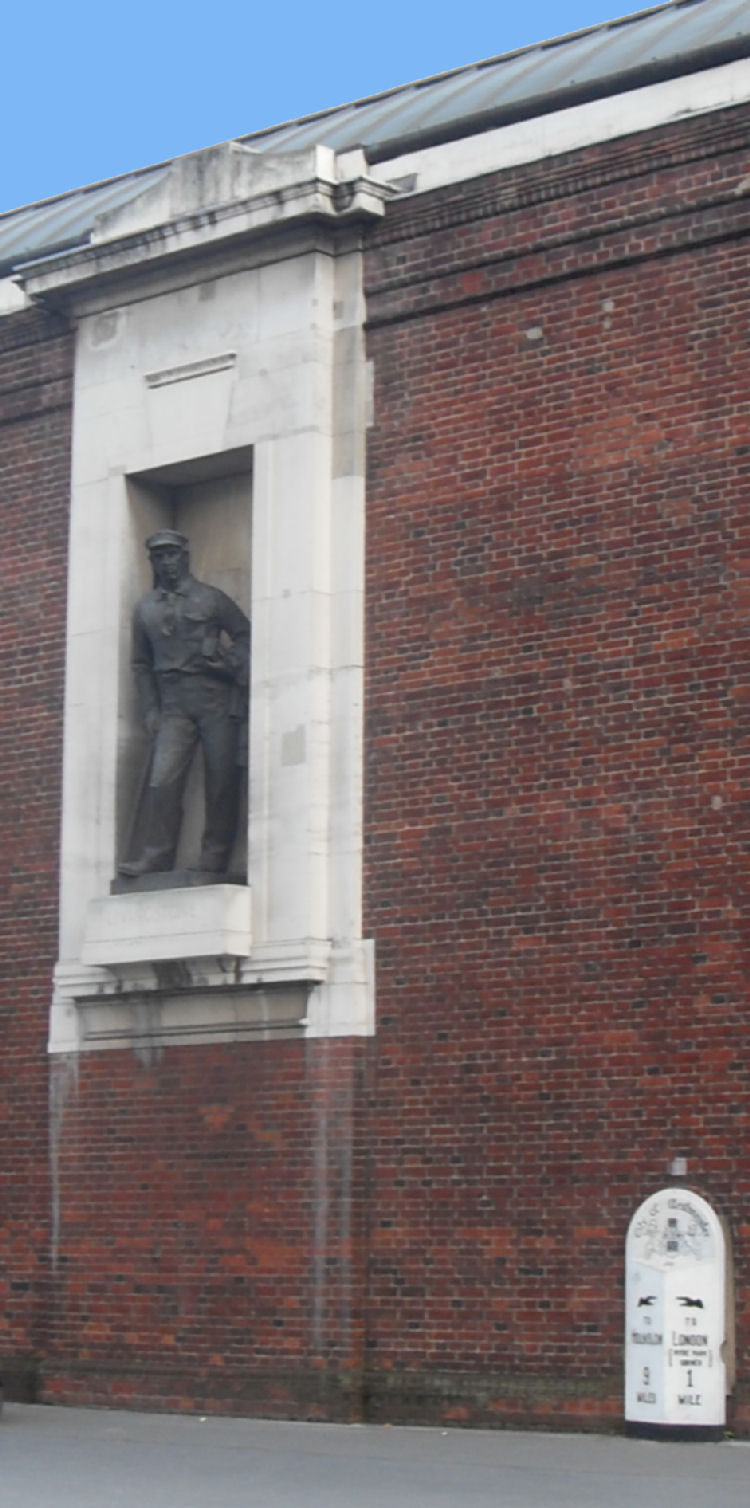
Dr. Livingstone, I presume?
This low-lying statue at Kensington Gore is of David Livingstone, born on 19 March 1813 in a small town in Scotland. In the year 1841, he began his trips from Kuruman into the African wilderness, where during 1843 he opened a new mission at Mabotsa. A year later in 1844 he was mauled by a lion and survived. Married in 1845 to Mary Moffat, (with whom he had 3 daughters and 3 sons). During 1849 he crossed Kalahari to find Lake Ngama, during 1851 he discovered Upper Zambesi, other geographical discoveries included the source of the Nile.
He was the first European ever to set eyes on Victoria Falls, which he named after his Queen.
Livingstone was awarded the gold medal of the Royal Geographical Society, who placed his statue in their alcove, just above the old milestone measuring the distance between London and Hounslow. Livingstone died in May 1873, in what was later to become Zambia. His body now rests in Westminster Abbey in London.
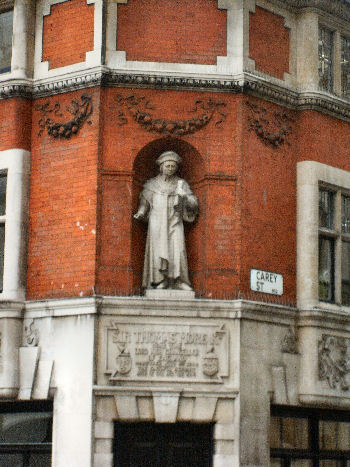
Sir Thomas More 7 February 1478 – 6 July 1535
English lawyer, author and statesman who gained a reputation as a leading humanist scholar, occupied many public offices, including Lord Chancellor (1529–1532), he had a number of people burned at the stake for heresy. More coined the word "utopia", a name he gave to an ideal, imaginary island nation, whose political system he described in the eponymous book published in 1516. He was beheaded in 1535 when he refused to sign the Act of Supremacy that declared Henry VIII Supreme Head of the Church of England.
In 1935, four hundred years after his death, Pope Pius XI canonised More in the Roman Catholic Church; More was declared Patron Saint of politicians and statesmen by Pope John Paul II in 1980. 1969 saw the inclusion of More's name in the General Roman Calendar, with a Memorial in which he is venerated with Saint John Fisher on 22 June, the day of the latter's death.
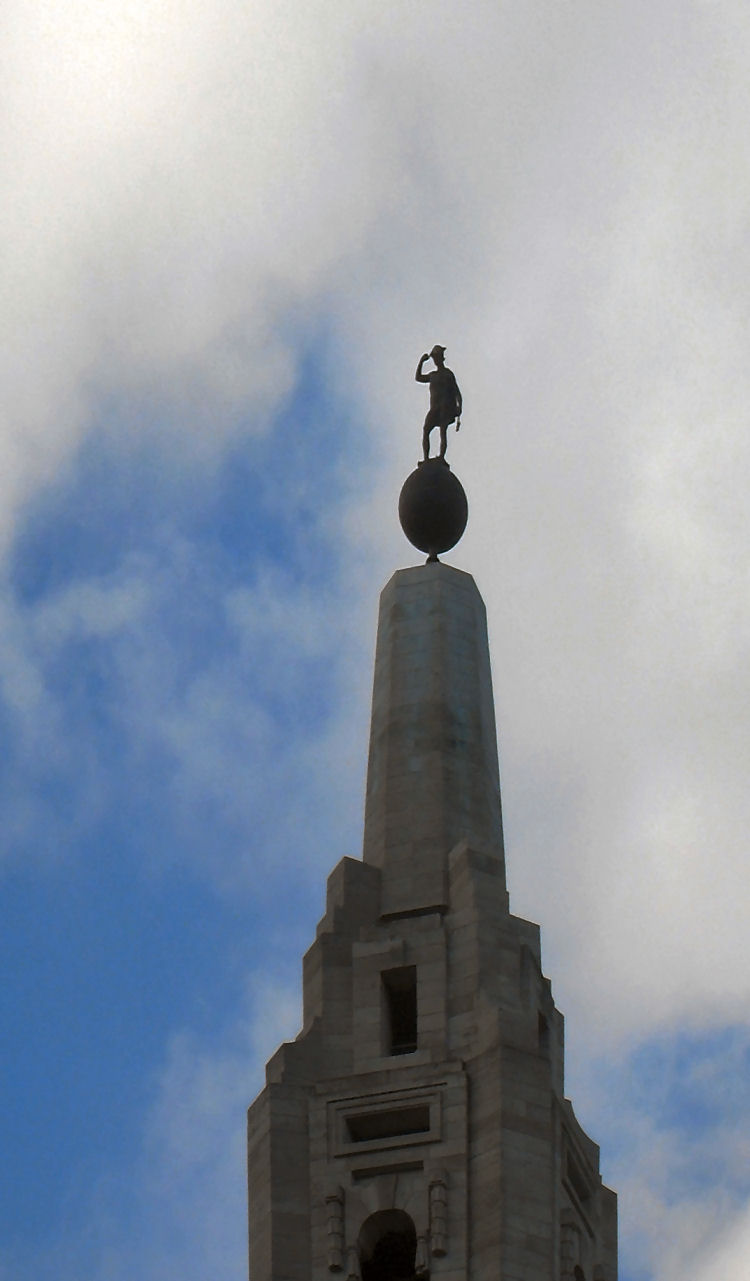
High up above the city skyline upon the rooftop of Triton Court, Finsbury Square, standing on the globe of the world, is a statue of the Roman God, Mercury. In the wide expanse of Finsbury Square,
where the office dweller takes advantage of a summers day, on the grassy banks of the square. Meanwhile, the sky's the limit for our golden god.

On the corner of Chancery Lane and 193 Fleet Street, is this statue representing Kaled, from the
Lord Byron poem Lara. The statue which was sculptured in white stone around the 1870's. It was placed into this alcove of the pawn brokers and jewellery emporium
of Messers. George Attenborough & Co when this building was first erected.
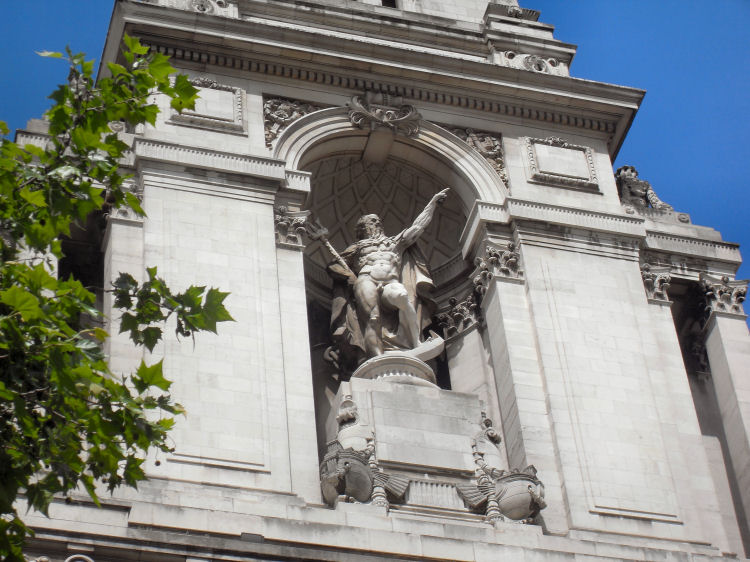
Old Father Thames points the way to Docklands from his perch above the magnificent
PLA (Port of London Authority) building at 10 Trinity Square.
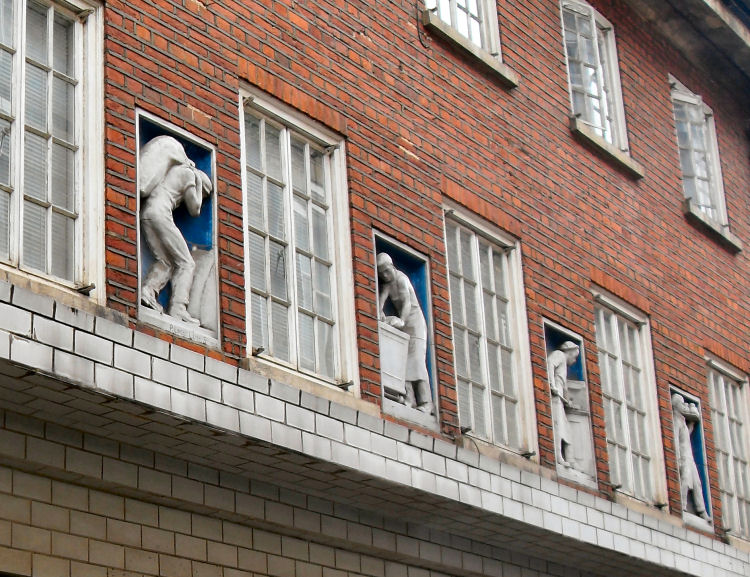
A row of statues perform the task of baking bread as if part of a film makers story board. With such superb eye for detail it is a pity these sculptures will never be seen performing their duty outside of this narrow side street in Spitalfields.
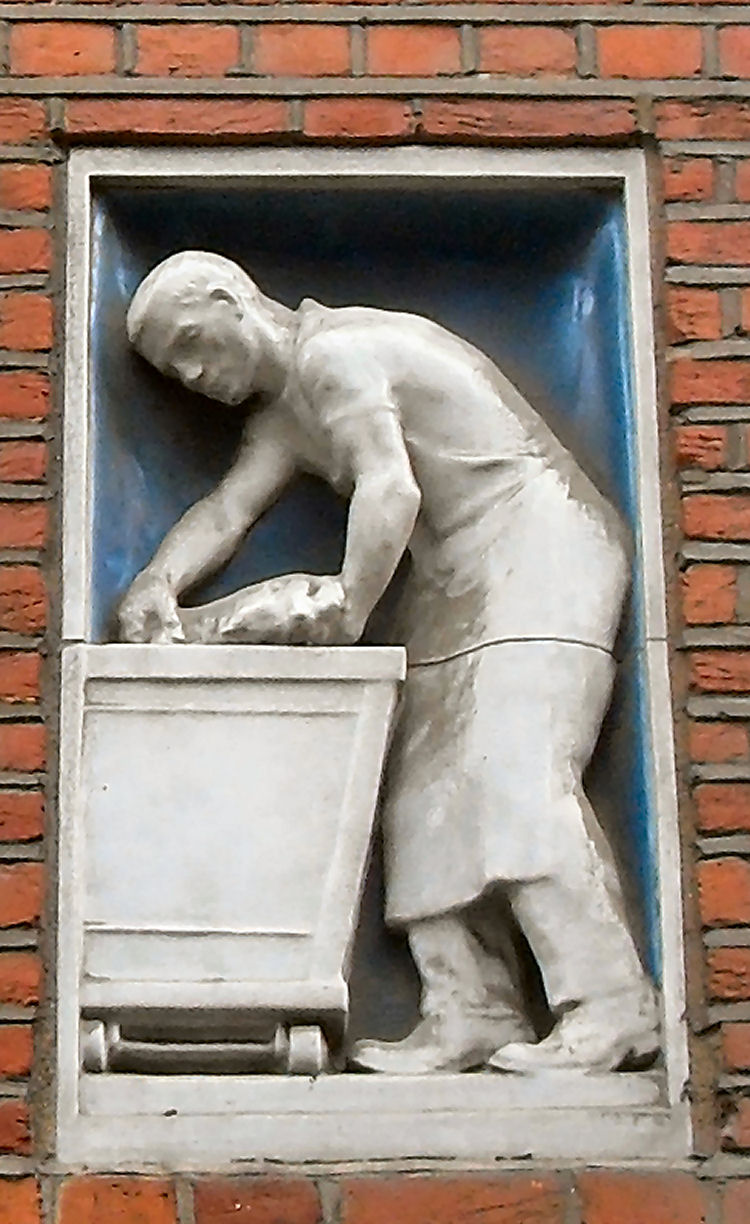
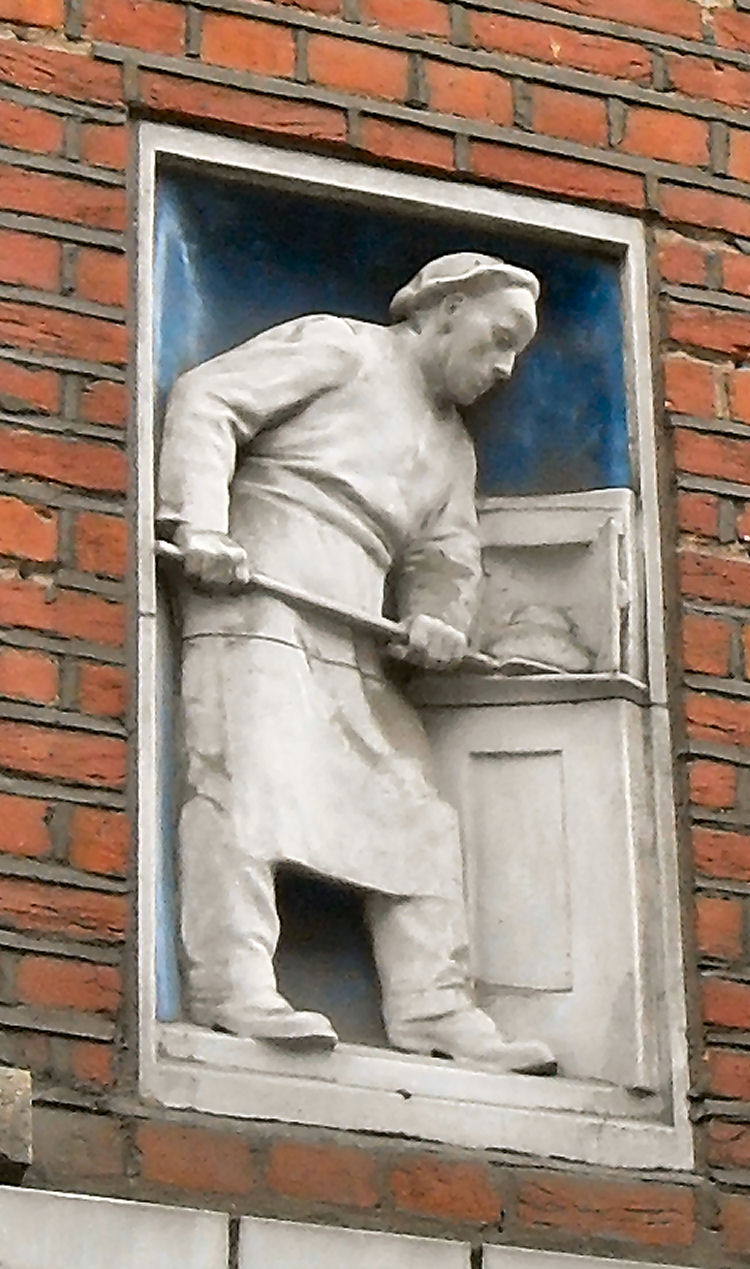
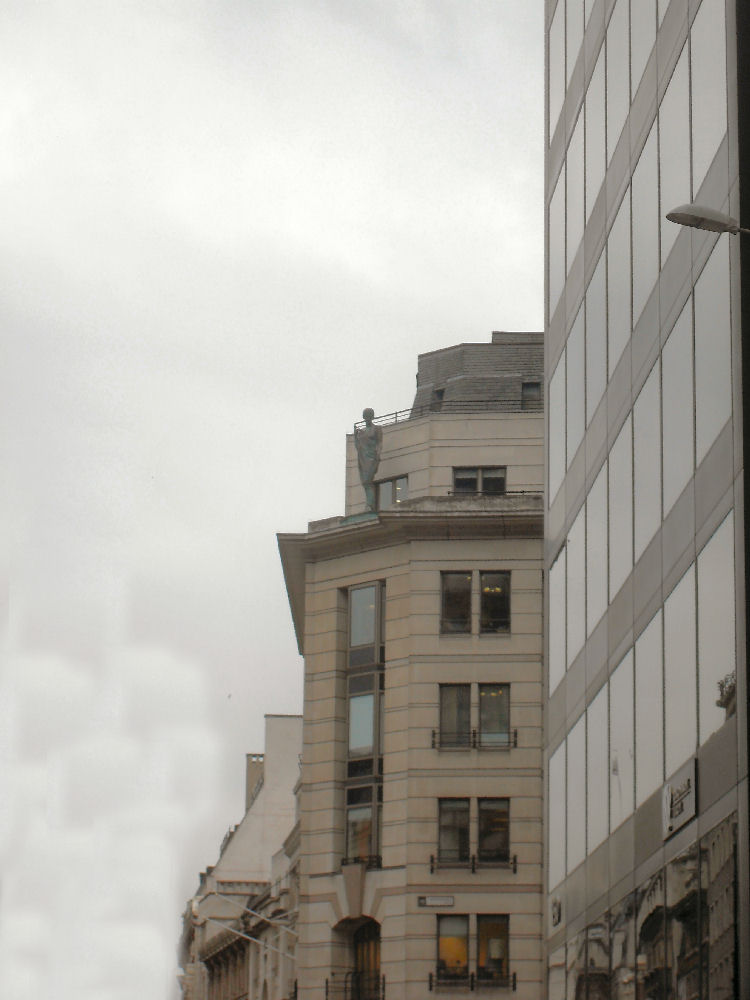
Why anyone would wish to add a statue to this nondescript office block is best left to the imagination. Meantime this ledge hanger looks on.

Not exactly the Nelson Column which springs to mind. This one has the Admiral keeping his eye out on Old Street below.

The Shakespeare's Head, Carnaby Street
The Shakespeare's Head which was built in 1735, was originally owned by Thomas & John Shakespeare, who were distant relatives of the poet, William Shakespeare.
In its early days, the tavern stood on the boundary line that divided the lands of the Mercers Company from those of Abingdon, and nearby was the small estate known as Six Acre Fields.
During the Victorian period, the field was the site of the riding school, belonging to Major Henry Foubert, whose name is commemorated by neighbouring Foubert's Place.
Looking up to the open window, unnoticed by drinkers and passersby alike, is Shakespeare's life size bust which appears to be gazing down at the busy street below. A close examination of the bust will show one of the poet's hands is missing. This occurred during World War II when a bomb dropped nearby.
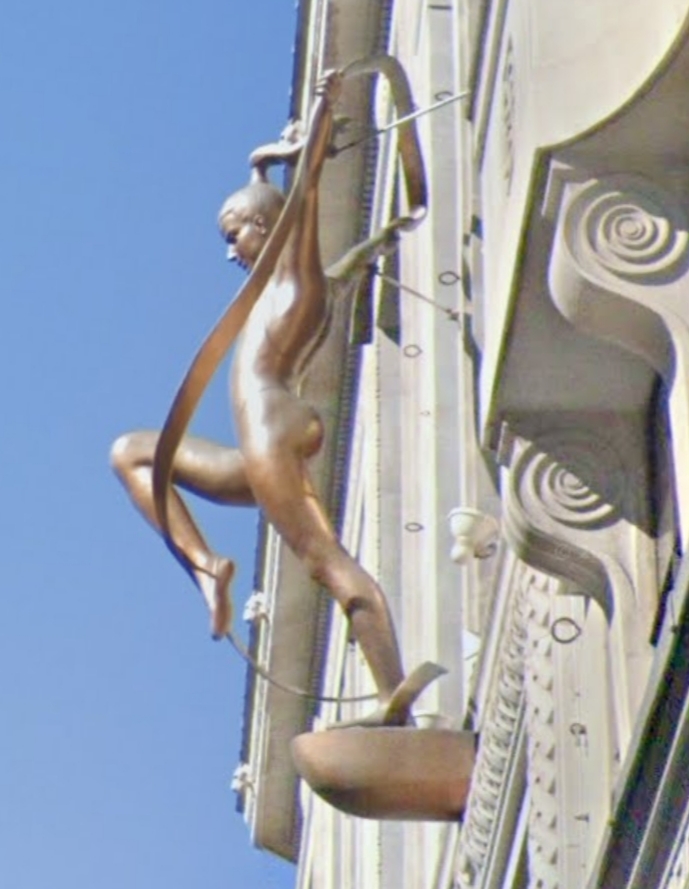
Dancer With Ribbon
How often have you walked along Oxford Street without noticing a statue inspired by Darcey Bussell?
A bronze likeness of the former ballerina and Strictly star above the entrance to The Plaza. Dancer With Ribbon, the statue created by sculptor Michael Rizzello in 1997,
 The contents of this website are the property of knowledgeoflondon.com and therefore must not be reproduced without permission. Every effort is made to ensure the details contained on this website are correct, however, we cannot accept responsibility for errors and omissions.
The contents of this website are the property of knowledgeoflondon.com and therefore must not be reproduced without permission. Every effort is made to ensure the details contained on this website are correct, however, we cannot accept responsibility for errors and omissions. Contact Us | Advertise
Contact Us | Advertise